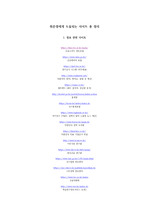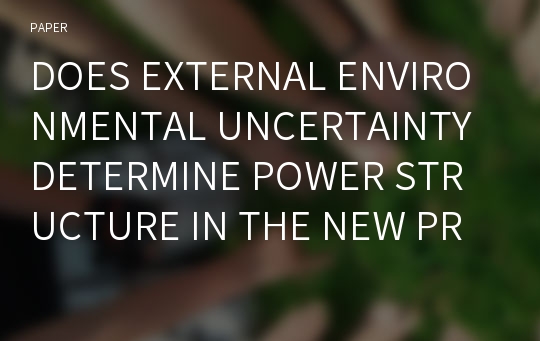DOES EXTERNAL ENVIRONMENTAL UNCERTAINTY DETERMINE POWER STRUCTURE IN THE NEW PRODUCT DEVELOPMENT PROCESS? THE ROLE OF NEW PRODUCT DEVELOPMENT DURATION
* 본 문서는 배포용으로 복사 및 편집이 불가합니다.
서지정보
ㆍ발행기관 : 글로벌지식마케팅경영학회(GFMC)
ㆍ수록지정보 : Global Marketing Conference
ㆍ저자명 : Chiayang Mac Chang, Lien-Ti Bei, Yung-Chien Lou
ㆍ저자명 : Chiayang Mac Chang, Lien-Ti Bei, Yung-Chien Lou
영어 초록
How to manage these marketing and R&D functions is very important in the new product development (NPD) process. Which function should have more power to make more decisions? Previous study seldom touched this question. Further, according to strategic contingent theory, perceived uncertainty is very important determinant for power structure in the NPD process (Hickson, Hinings, Schneck, & Pennings, 1971). However, Pfeffer and Salancik (1978) argued that there is indeterminacy between environment and power structure. Thus, is external environmental uncertainty related to power structure in the NPD process? Resource dependence theory gives us a hint to solve this puzzle, that is, the concept of institutionalization (Pfeffer, 1981; Pfeffer and Salancik, 1978). The current study tends to adopt NPD duration reflected institutionalization (Pfeffer, 1981) to examine the moderating effect of NPD duration on the relationship between environmental uncertainty and marketing-R&D power structure in the NPD process. In general, power is defined as that the relation among social actors in which a specific social actor can potentially influence the decision to achieve his or her desire outcomes (Dahl, 1957; Emerson, 1962; Pfeffer, 1981; Salancik & Pfeffer, 1977). This definition also suggested that power is the structure in human aggregates like complex organization (Pfeffer, 1981). Thus, the power structure in the NPD process is defined as the proportion of decision making by marketing and R&D functions in the NPD process. When a NPD team faces the high market uncertainty, marketing function can gather more resources because of its special ability. A new product team has the limited resources, so another important function like R&D will have fewer resources than marketing function. Thus, our first hypothesis is that the higher market uncertainty, the more power marketing function has. R&D members have background knowledge to overcome the difficult of processing technological language and decide the main resolutions. The team will tend to allot more resources to deal with the problems of technological change as such the R&D members can buy the license of new technologies to apply it on their new products and to create the disruptive innovation like smartphones or tablets successfully. Therefore, the second hypothesis is that the higher technology uncertainty, the more power R&D function has. According to resource dependence theory, however, the relationship between environmental uncertainty and power structure does not always exist (Pfeffer, 1981; Pfeffer & Salancik, 1978). Pfeffer and Salancik (1978) indicated that the perceived environmental uncertainty of a subunit is weakly related to subunit’s power structure when an organization is highly institutionalized. When one subunit has more power than others, it tends to maintain the current power structure. So, the subunit makes rules or norm to formalize its power legally. This process is so called institutionalization (Pfeffer, 1981; Pfeffer & Salancik, 1978). In general, as time goes by, organizations will form their own social norms, and some of these norms will become the principles or rules in organizations (Pfeffer, 1981). As a result, when NPD time is long, marketing and R&D functions form norms or official rules. Then, the relationship between their perceived environmental uncertainty and power structure in the NPD process is weaker than the relation in the shorter duration of NPD. Therefore, our hypothesis is that the relationship between environmental uncertainty and power structure in the long-run project time is weaker than the relationship in the short-run project time. The current study used questionnaire survey and purposive sampling method to collect data. In order to eliminate the bias of common method variance (CMV), this study conducted multiple sources including project managers, the member charging marketing, and the member charging R&D to administrate questionnaires differently. In order to avoid selection bias, this study, moreover, asked the informants select the most recent new products developed and launched for minimum of twelve months. We sent three types of questionnaires to project managers, the member charging marketing, and the member charging R&D respectively. The current study sent questionnaires to 112 firms, and 69 firms are returned. The response rate is 61.61%. At new product level, there are 207 new product projects, and 100 firms are returned. The response rate is 48.31%. We also do tests of bias due to nonresponse which were conducted by using a comparison of early to late respondents’ all variable means (Armstrong & Overton, 1977). No evidence of a bias was found. Our variables are included market and technology uncertainty, and power structure which the left side is totally decided by marketing and the right side is totally decided by R&D. Moreover, NPD time is from star-up projects to launch it. In order to rule out other effects, we controlled industrial category, firm age, the number of marketing and R&D members involved in the NPD process, environmental hostility, and NPD process formalization. Every overall fit index in our measurement model is shown that χ(55)^2=71.5259,p-vaule=.066,χ^2/df=1.30<2, goodness of fit index=.90,adjusted goodness of fit index=.84,comparative fit index=.97,normed fit index=.87,non-normed fit index=.95, and root mean square error of approximation=.06. In general, all fit indexes in our measurement model are acceptable, and the average variance extracted (AVE), composite reliability (CR), and Cronbach’s α of all constructs are acceptable. Their ranges are .45-.70, .70-.93, and .75-.93 respectively. The overall model showed that the higher market uncertainty, the more power marketing has (β=-.279, t-value=-3.11, p-value<.050) but technology uncertainty is not significantly related to power structure. We used the mean of the NPD time as the cutting point to split short-run and long-run project time, and the mean is about one year and half in our sample. The result showed that in the short-run group the higher market and technology uncertainty, the more power marketing and R&D function have (β=-.355, t-value=-2.53, p-value<.050; β=.296, t-value=2.23, p-value<.050) . However, in the long-run group the relationship between environmental uncertainty and power structure is statistically insignificant. Additionally, in the long-run group the more NPD process formalization, the more power R&D function has (β=.277, t-value=2.33, p-value<.050). Back to the original puzzle, that is, does external environmental uncertainty determine power structure in the new product development process? The empirical evidence is shown that it is dependent on how long an organization develops new products to the market. Because the dominant subunit involved in the NPD process tends to maintain it power, it institutionalizes rules or norms to have legitimacy in the organization, and this argument is consistent with resource dependence theory (Pfeffer & Salancik, 1978). We also found that in short-run perceived environmental uncertainty are positively related to power structure in the NPD process. Consistent with strategic contingent theory’s proposition, the one subunit enable to reduce or respond external environment pressure, and it can have more power in the organization (Hickson, et al., 1971; Hinings, et al., 1974). We additionally found that in long-run group process formalization is positively related to R&D power. R&D function plays a main role in the NPD process as especially in the manufacturing industry; therefore, R&D function has much motive to maintain its power (Workamn, 1993). So R&D function can use formal rule to maintain its power when R&D function formalize the NPD process. As a consequence, formalizing the NPD process helps R&D function to gain more power in the long run. The contribution of our study is that we tested the proposition in strategic contingent theory, and the empirical evidences supported our hypotheses. Furthermore, our study also is the first study to test and find the support evidence with the institutionalization proposition in resource dependence theory. We not only explored the relationship between environmental uncertainty and power structure in the NPD process, but also extended strategic contingent theory and resource dependence theory to the NPD research. The further study can follow our definition of power structure to find what strategy marketing and R&D function will used to take back or maintain their power (Eisenhardt & Bourgeois, 1988; Li & Atuahene-Gima, 2001; Pfeffer, 1981).참고 자료
없음태그
"Global Marketing Conference"의 다른 논문
 THE ROLES OF GREEN PACKAGING IN UGLY FOOD PURCHASE INTE..22페이지
THE ROLES OF GREEN PACKAGING IN UGLY FOOD PURCHASE INTE..22페이지 THE IMPACT OF INDUCED AWE ON ETHICAL TOURIST BEHAVIORS5페이지
THE IMPACT OF INDUCED AWE ON ETHICAL TOURIST BEHAVIORS5페이지 A BIBLIOMETRIC ANALYSIS OF SPIRITUAL TOURISM RESEARCH15페이지
A BIBLIOMETRIC ANALYSIS OF SPIRITUAL TOURISM RESEARCH15페이지 SOCIAL NETWORK ANALYSIS AND RESPONSE TIME TESTING: CONS..11페이지
SOCIAL NETWORK ANALYSIS AND RESPONSE TIME TESTING: CONS..11페이지 THE EFFECTS OF PARA-SOCIAL INTERACTION ON ONLINE CELEBR..3페이지
THE EFFECTS OF PARA-SOCIAL INTERACTION ON ONLINE CELEBR..3페이지 THE INFLUENCE OF OPINION LEADERS ON DAILY DEALS USER’S ..3페이지
THE INFLUENCE OF OPINION LEADERS ON DAILY DEALS USER’S ..3페이지 HOW IMMERSIVE RETAILING AFFECTS CONSUMERS’ URGE TO BUY:..6페이지
HOW IMMERSIVE RETAILING AFFECTS CONSUMERS’ URGE TO BUY:..6페이지 KEY TO SUPERSTARDOM IN A GLOBALISED MARKET: THE ROLE OF..6페이지
KEY TO SUPERSTARDOM IN A GLOBALISED MARKET: THE ROLE OF..6페이지 A POST-PANDEMIC LOOK AT TOURISTS’ PERCEIVED COOLNESS OF..4페이지
A POST-PANDEMIC LOOK AT TOURISTS’ PERCEIVED COOLNESS OF..4페이지 EXTRACTING OFFLINE RETAIL SHOPPING PATTERNS: OLLABORATI..5페이지
EXTRACTING OFFLINE RETAIL SHOPPING PATTERNS: OLLABORATI..5페이지

























